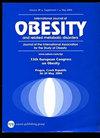The impact of obesity on chronic oedema/lymphoedema of the leg – an international multicenter cross-sectional study (LIMPRINT)
IF 4.2
2区 医学
Q1 ENDOCRINOLOGY & METABOLISM
引用次数: 0
Abstract
Obesity and chronic oedema/lymphoedema are two distinct but related conditions, rarely investigated together. The aim was to study the impact of increased weight on chronic oedema and related factors. A cross-sectional study, 38 centers, nine countries. Patients with clinically confirmed chronic oedema/lymphoedema of the leg were included. Weight category was estimated as: normal weight (BMI 20–30), class I-II obesity (BMI 30–40), or class III obesity (BMI > 40). Factors were tested for an association with increased weight, using a multivariable model. A total of 7397 patients were included; 43% with normal weight, 36% class I-II obesity and 21% class III obesity. Increased weight was associated with more advanced stages of chronic oedema (ISL stage III; the most advanced form); affecting 14% in normal weight, 18% class I-II obesity and 39% class III obesity (p < 0.001). Ten factors were independently associated with increased weight: diabetes (OR 2.4), secondary lymphoedema (OR 2.7), cellulitis/erysipelas within 12 months (OR 1.2), bilateral lymphoedema (OR 3.6), compression therapy (OR 2.1), increased swelling duration (1–2 years OR 1.3, 2–5 years OR 2.5, 5–10 years OR 3.6, >10 years OR 3.5) decreased mobility (walking with aid OR 1.9, being chair bound OR 1.2) and age (reference<45 years; 45–64 years OR 1.5, 75–84 years OR 0.6, 85+ years OR 0.2). Increased weight was associated with a lower presentation of peripheral arterial disease (OR 0.7) and poorer chronic oedema control (OR 0.8). Patients with obesity had lower function, appearance and more severe symptoms (LYMQOL) and lower quality of life (EuroQol). Obesity negatively impacts chronic oedema, leading to more advanced stages. Achieving good control of swelling with compression is more difficult in these patients. Increased awareness of chronic oedema/lymphoedema as a complication of obesity is important for early detection and for developing effective strategies to prevent and manage them.肥胖对腿部慢性水肿/淋巴水肿的影响--国际多中心横断面研究(LIMPRINT)。
背景/目的:肥胖和慢性水肿/淋巴水肿是两种不同但相关的疾病,很少同时进行研究。本研究旨在探讨体重增加对慢性水肿及相关因素的影响:横断面研究,9 个国家的 38 个中心。研究对象包括经临床确诊的腿部慢性水肿/淋巴水肿患者。体重类别估计为:正常体重(体重指数 20-30)、I-II 级肥胖(体重指数 30-40)或 III 级肥胖(体重指数大于 40)。使用多变量模型检验了各种因素与体重增加的关系:共纳入 7397 名患者,其中 43% 为正常体重,36% 为 I-II 级肥胖,21% 为 III 级肥胖。体重增加与慢性水肿的晚期(ISL III 期,即最晚期)有关;体重正常者占 14%,I-II 级肥胖者占 18%,III 级肥胖者占 39%(P 10 年 OR 3.5),活动能力下降(借助辅助工具行走 OR 1.9,坐轮椅 OR 1.2),年龄增大(参考结论:肥胖会对慢性水肿产生负面影响,导致病情更加严重。这些患者更难通过加压来控制肿胀。提高对慢性水肿/淋巴水肿作为肥胖并发症的认识,对于早期发现并制定有效的预防和管理策略非常重要。
本文章由计算机程序翻译,如有差异,请以英文原文为准。
求助全文
约1分钟内获得全文
求助全文
来源期刊

International Journal of Obesity
医学-内分泌学与代谢
CiteScore
10.00
自引率
2.00%
发文量
221
审稿时长
3 months
期刊介绍:
The International Journal of Obesity is a multi-disciplinary forum for research describing basic, clinical and applied studies in biochemistry, physiology, genetics and nutrition, molecular, metabolic, psychological and epidemiological aspects of obesity and related disorders.
We publish a range of content types including original research articles, technical reports, reviews, correspondence and brief communications that elaborate on significant advances in the field and cover topical issues.
 求助内容:
求助内容: 应助结果提醒方式:
应助结果提醒方式:


